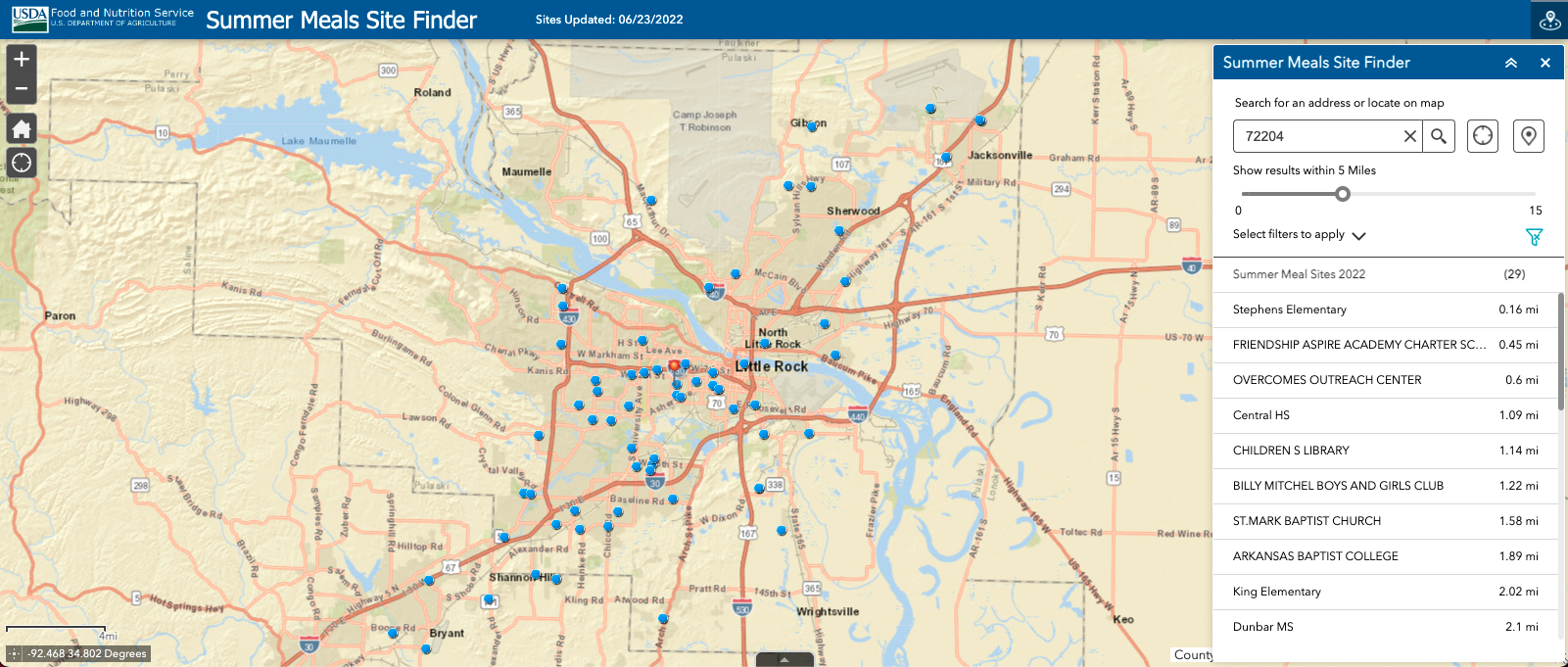June 27, 2022
Find summer meal sites for k-12 students using USDA’s “Find Meals for Kids” map
By Rebekah Hall
U of A System Division of Agriculture
Fast Facts:
- USDA’s “Find Meals for Kids” map shows information on summer meal sites
- Summer months can be especially difficult for families facing food insecurity
- Nutritious meals are critical for child, adolescent development
(631 words)
LITTLE ROCK — For Arkansas families facing food insecurity, the summer months can
be especially difficult. Children who are eligible for free and reduced-cost meals
during the school year may not have access to regular meals during the summer break.
To help fill this gap, parents and caregivers of K-12 students can find information
about summer meal sites in their communities using the U.S. Department of Agriculture’s
Summer Food Service Program “Find Meals for Kids” map.
Bryan Mader, assistant professor and health specialist for the University of Arkansas System Division of Agriculture, said the USDA’s “Find Meals for Kids” map shows USDA-operated sites that serve as many as three meals to each child per day.
Mader said that without summer meal programs, students may not have access to regular meals throughout the day, which “can harm a child’s physical and social development.
“There is a lot of scientific research that tells us those children who miss breakfast and lunch are more likely to be absent from school, inattentive when they attend school and more likely to be sick overall,” Mader said. “They may also score lower on tests and be less likely to complete schoolwork than their peers who eat breakfast and lunch. These meals are important because it allows every student to have access to a nutritious meal regardless of their family’s income.”
Households can also text “Summer Meals” to 97779 or call 866-348-6479 to search for summer meals in their area. In Arkansas, this program is administered by the Arkansas Department of Human Services’ Arkansas Special Nutrition Program. Children 18 and younger may receive free meals through the program.
Developmental impact
Access to nutritious meals is key for the immediate and long-term health of developing
children.
“As developmental change takes place in young children and adolescents, so too does the formation of lifelong dietary patterns in this age group,” Mader said.
Young children rely on others to provide meals and teach nutrition skills. But as children age into adolescence, they gain autonomy in their food choices. Their dietary patterns are determined by an increasing number of factors, including social support and exposure to marketing, Mader said. This can result in dietary patterns that are full of sugar, high sodium and processed foods, which leads to chronic diseases such as type II diabetes, obesity and heart disease.
Mader said nutrient-dense dietary patterns, such as those including a wide variety of fruits, vegetables and appropriate amounts of protein, aid in the physiological, emotional and social development of children and adolescents. However, regular access to these kinds of foods can be difficult for many Arkansas families, due to physical, geographic or economic barriers, such as food deserts — low-income areas where residents have limited access to healthy and affordable foods.
COVID boost
In March 2020, Congress gave the USDA the authority to issue nationwide child nutrition
waivers through the Families First Coronavirus Response Act. The USDA then worked
with school districts, non-profits and other community organizations to waive many
of the traditional requirements for their feeding programs. This made free school
meals available to all children, regardless of income.
“This helped ensure that children who relied upon school meals for their nutritional needs would not miss those important meals, which they may not be able to get at home,” Mader said.
Unfortunately, Mader said, these child nutrition waivers are set to expire on June 30, 2022.
“Despite a push from several anti-hunger and nutrition advocates at the federal level, the Senate ultimately did not include continued funding for these waiver programs,” Mader said. “The USDA’s top leadership, the Secretary of Agriculture, does not have the power to renew these waivers, as that power rests solely with Congress.”
For more information about food and nutrition, visit the Cooperative Extension Service’s Food and Nutrition Resources Page.
To learn about extension programs in Arkansas, contact your local Cooperative Extension Service agent or visit www.uaex.uada.edu. Follow us on Twitter and Instagram at @AR_Extension. To learn more about Division of Agriculture research, visit the Arkansas Agricultural Experiment Station website: https://aaes.uark.edu. Follow on Twitter at @ArkAgResearch. To learn more about the Division of Agriculture, visit https://uada.edu/. Follow us on Twitter at @AgInArk.
About the Division of Agriculture
The University of Arkansas System Division of Agriculture’s mission is to strengthen agriculture, communities, and families by connecting trusted research to the adoption of best practices. Through the Agricultural Experiment Station and the Cooperative Extension Service, the Division of Agriculture conducts research and extension work within the nation’s historic land grant education system.
The Division of Agriculture is one of 20 entities within the University of Arkansas System. It has offices in all 75 counties in Arkansas and faculty on five system campuses.
Pursuant to 7 CFR § 15.3, the University of Arkansas System Division of Agriculture offers all its Extension and Research programs and services (including employment) without regard to race, color, sex, national origin, religion, age, disability, marital or veteran status, genetic information, sexual preference, pregnancy or any other legally protected status, and is an equal opportunity institution.
# # #
Media Contact:
Rebekah Hall
rkhall@uada.edu
@RKHall_
501-671-2061
